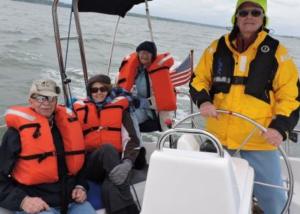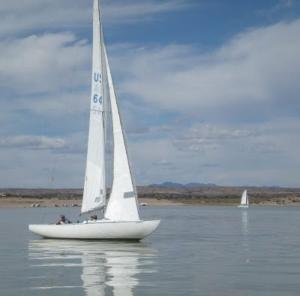People ask, “What’s the best way to sail like a pro?” Don’t forget to wear an ascot.
-
WATCH VIDEOS—This is a good first step because you can choose from myriad short videos on You Tube to see how things work. Focus at first on the Close Reach, Beam Reach and docking. The rest is details.
-
 READ BEGINNER BOOK—“Sailing for Dummies” has sold in the tens of thousands. It presents all the principles clearly and cleverly. The only drawback is nomenclature. Don’t get discouraged by new words, just try to connect the dots from the book to the videos. Pay attention to the safety factors of life preservers, boat shoes, etc. Safety counts.
READ BEGINNER BOOK—“Sailing for Dummies” has sold in the tens of thousands. It presents all the principles clearly and cleverly. The only drawback is nomenclature. Don’t get discouraged by new words, just try to connect the dots from the book to the videos. Pay attention to the safety factors of life preservers, boat shoes, etc. Safety counts. -
TAKE A CLASS—Local parks and rec organizations offer sailing classes. The American Sailing Association has sailing schools all over the country to teach 101 Basic Keel Boat Sailing and 103 Basic Coastal Cruising. Classes usually run Saturday and Sunday. Many couples take the class together for reinforcement and safety.
-
JOIN A CLUB—Once you graduate from the ASA courses, you can take their boats out on a membership plan that allows a set number of cruises per month. And the best part is that as a certified sailor you can go out without the instructor. So you’re on your own. By now you will have learned the nomenclature and the value of knowing all the terms. It’s not just pirate talk. Other joining options are Carefree Boat Club and Freedom Boat Club, located all over the U.S. Keep in mind that most of these fleets are motorboats, but you’ll find some sailboats as well.
-
GO SEE MARINAS—Walking the docks of local and regional marinas is fun because you get to see all kinds of boats in their native setting. Then you can differentiate among the lengths to see how bigger boats have more stuff. And you can see how people tie off their lines. Find a size of boat that appeals to you and take notes, or a photo, for future reference. Always ask for rates on slips.
-
 JOIN A CREW—Ask around on the docks about the Wednesday night races at the local yacht club. Members welcome volunteers to crew. And you don’t have to be an expert to crew, yet your skills will improve markedly as a result. Eventually you can join the yacht club—without having to own a boat.
JOIN A CREW—Ask around on the docks about the Wednesday night races at the local yacht club. Members welcome volunteers to crew. And you don’t have to be an expert to crew, yet your skills will improve markedly as a result. Eventually you can join the yacht club—without having to own a boat. -
PRACTICE—As with any sport, practice matters. Try to carve out one afternoon a weekend to read, watch, walk or sail. Concentrate on the Close Reach.
-
CHOOSE A BOAT—Resist the temptation to buy just yet. You and your spouse need to agree on what type of sailing you want to pursue now:
-
Day-sailing on a small body of water requires nothing more than a 22-foot keel boat, exactly what ASA offers.
-
Cruising for the day requires 25 or 30 feet, with a cabin below for storage and a head.
-
Cruising for the weekend moves you up to 32 or 36 feet. As a result, the range of distance is three times that of a 22, and the cabin is comparatively luxurious.
-
-
 RENT A BOAT—Websites such as getmyboat.com and boatbound.com offer dozens of local boats for rent by owner. The beauty is that the program screens owners for the boat specs and includes liability insurance. Now type in where you want to sail, say Virginia, and hundreds of boats pop up. Note: Specify sailboats to filter out motorboats, and specify “Cruising Monohulls” to narrow the field. Plus, you can rent for a half-day, day or several days. The owner will likely accompany you as a certified captain. That’s great because you can ask about the boat, the venue, the waters, the sailing, the problems and joys.
RENT A BOAT—Websites such as getmyboat.com and boatbound.com offer dozens of local boats for rent by owner. The beauty is that the program screens owners for the boat specs and includes liability insurance. Now type in where you want to sail, say Virginia, and hundreds of boats pop up. Note: Specify sailboats to filter out motorboats, and specify “Cruising Monohulls” to narrow the field. Plus, you can rent for a half-day, day or several days. The owner will likely accompany you as a certified captain. That’s great because you can ask about the boat, the venue, the waters, the sailing, the problems and joys. -
EXPLOIT VACATION—Go the Caribbean and enjoy at least one day on a 100-foot tourist cruise for snorkeling and sightseeing. Your objective is not to sail the boat but to interview the captain about everything relevant to ownership. Or the next tine you go to San Francisco or Galveston or wherever, rent a boat for the afternoon with a captain aboard.

-
BUY YOUR DREAM BOAT—Finally you’re ready to buy and have narrowed the field to a size and price for the greatest outdoor adventure in your life. Next, go rent a version of that boat at least twice to be sure it’s right. Then rent one size larger and compare the two. Go bigger even if you think you can’t afford it. As for price, most people buy used rather than new because the boat is broken in and much less expensive. The internet has flattened the market so that prices are quite reasonable across the board. Don’t expect to find a bargain unless it’s a fixer-upper. The video below is taken from the Sail Life series “Nervous Sailor” and offers excellent tips about what to look for in a used boat. My rule: Don’t buy any boat older than 1990.
Let’s Learn How to Sail Like a Pro
Scroll down Rates and pick a day for a sailboat charter. Scroll down Reviews on Trip Advisor. Go back to the Home Page of Williamsburg Charter Sails.
how to sail like a pro how to sail like a pro how to sail like a pro



